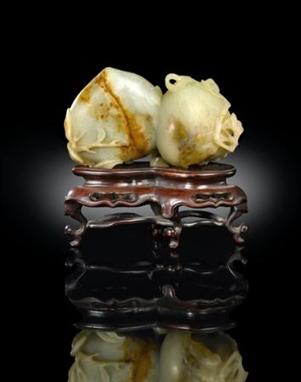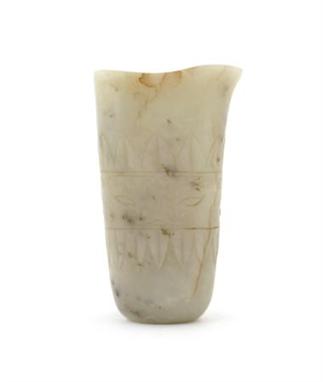We found 400965 price guide item(s) matching your search
There are 400965 lots that match your search criteria. Subscribe now to get instant access to the full price guide service.
Click here to subscribe- List
- Grid
-
400965 item(s)/page
A Collection of Peridot Set Jewellery, including an Edwardian seed pearl and peridot pendant on a rope link chain in a fitted case, pendant measures 3.4cm by 4.8cm, chain length 38.8cm, an early 20th century peridot and diamond three stone bar brooch, measures 7.6cm by 0.8cm, an early 20th century peridot and lozenge shaped link bracelet, length 19cm, and a pair of peridot and seed pearl drop earrings, a pear cut peridot within a cluster of seed pearls, with screw-on fittings, drops measure 2.7cm
A good Chinese bronze incense burner, probably 18th century. Crisply cast with animal mask handles and a central band of mythical beasts including dragons and winged horses, the rim and foot with stylized scroll work, the base with a four character mark Yu Tang Shi Sou (Jade Hall Stone Old Man), the body with a warm brown patina, 28.5cm. This rare mark including the characters for Shi Sou is more commonly found on figures.
A small Chinese pale celadon jade carving of a mythical beast, probably Song dynasty. Walking in a menacing pose with its head raised, baring its teeth, the tail curled around its legs, the stone with pale brown striations, 7.5cm. Provenance: purchased in Hong Kong during the 1950s, by repute.
An extremely rare and fine Chinese Imperial soapstone brushwasher, rare gilded Qianlong mark and of the period 1736-95. The octofoil form engraved with stylized lotus between key fret borders, the stone a dark red brown colour with paler striations, raised on a carved hardwood stand, 15.6cm. (2) Provenance: an English private collection. The Qian or Heaven Trigram between two dragons (long) reveals the Chinese Emperor’s love of wordplay. This pure Yang trigram was also suitable for an emperor, being known as the father of the trigrams.
A small Chinese jade carving of a rolling horse, probably 17th century. Stretching its head around to gnaw at its rear hoof and its tail curled beneath it, the creamy coloured stone flecked with brown striations, 7cm. Provenance: from the deceased estate of a New York collector. Cf. Watt, Chinese Jades from Han to Ch’ing, no.64, p.8, where he illustrates a Tang dynasty jade depicting the same theme and notes that the coiled position ‘is similar to stone or pottery lions of the Tang period with one of the hind paws at the mouth or scratching one ear’. The horse ‘Ma’, is a symbol of speed and of peace, because in ancient China they were used to bring peaceful tidings.
A small Chinese pale celadon jade carving of a cat and her kitten, 18th/19th century. The stone flecked with dark markings, together with a wood stand, 4.5cm. (2) Provenance: from the deceased estate of a New York collector. The Chinese name for ‘cat’, Mao, is homophonous with the word for ‘age eighty to ninety’. The cat is thus a symbol of longevity.
A Fine and Rare Large Chinese Spinach-Green Jade Figure of Gautama Buddha. Qing dynasty, 18th century, 23.2cm. Well carved and seated in dhyanasana with his hands held together in dharmacakra and dressed wearing long flowing robes exposing his chest and right shoulder. His benevolent face with eyes downcast beneath a protruding urna beneath whorls of hair. The stone of an even colour with pale flecks. Provenance: A Scottish private collection, purchased in the 1950s. Catalogue note: For further jade carvings of Buddha, cf. Chinese Jades in the Stanley Nott Collection, pl.XII; see also, Treasures from the Snow Mountains, Gems of Tibetan Cultural Relics, Chen Xiejun, & Wang Qingzheng, no.37; and Zhongguo yuqi quanji, p.629, no.334 for a related jade seated figure of Buddha in the Palace Museum, Beijing.
Lord Alington of Crichel. Napier George Henry Sturt, the 3rd Baron Alington of Crichel, was born in 1896 and succeeded to the title in 1919. In 1928 he married Lady Mary Sibell Ashley-Cooper, and their only child, Mary Anna Sibell Elizabeth Sturt, was born the following year. Along with the Sitwells, Lord Alington was a founder member of the Magnasco Society, which was formed in London in the 1920s by a group of elite connoisseurs to revive the Baroque style. With its theatrical fantasy it offered an alternative to the pre-war simple elegance and the post-war Art Deco modernism. The Magnasco Society organised exhibitions of seventeenth-century art and, through aficionados including Cecil Beaton and Lord Gerald Wellesley, became synonymous with a neo-Baroque interior style fashionable for that decade. In 1940, Lord Alington was commissioned as an RAFVR officer and posted to Cairo in July, where he died of pneumonia two months later. As he died without male issue, the title of Baron Alington of Crichel became extinct on his death. A Massive Chinese Mottled-Grey Jade Carving of a Recumbent Water Buffalo. Qing dynasty, 18th/19th century, 29.5cm. Carved from an enormous grey-green boulder dappled with darker more vivid and with paler mottling. The beast lies on its side with its head turned to the left which is resting on a front leg. The face has a pleasing contented expression with well defined eyes and nose, and with the horns curling around the neck. The coat is carved with loosely fitting skin through which the ribs and vertebrae are visible. The finely incised tail is thrown over massive haunches; the hooves are all well defined. Provenance: The Hon. Mrs Mary Anna Marten OBE (1929-2010), Crichel House, Dorset. Purchased prior to 1953. Exhibited: Chinese Jade Throughout the Ages, an exhibition organised by the Arts Council of Great Britain and the Oriental Ceramic Society, May-June 1975, Victoria and Albert Museum, catalogue no.396, where it is described as Ming dynasty. Catalogue note: For other massive jade carvings of water buffaloes, cf. Chinese Jade Throughout the Ages, an exhibition organised by the Arts Council of Great Britain and the Oriental Ceramic Society, May-June 1975, Victoria and Albert Museum, no.395 and 397, the latter from the collection of Somerset de Chair. In the introduction to chapter XIX, Large Animal, Ming and Ch’ing Periods, they are discussed as being: ‘among the most ambitious and monumental examples of jade ever worked in China; and perhaps all of them once had their place in the pavilions and various palaces in Peking.’ See also J C S Lin, The Immortal Stone, Chinese jades from the Neolithic period to the twentieth century, pp.48-50.
An Extremely Rare Chinese Imperial Gilded Spinach-Green Jade Buddhist Lion Dog. Qing dynasty, Qianlong period 1736-95, 20cm. Boldly carved from a massive spinach-green boulder, crouching with his head turned to the left and baring his teeth to reveal a slightly upturned tongue. The face with large eyes above a ruyi-shaped nose, tilts upwards; the angular chin is fringed with a short curling beard. His floppy scroll-like ears fall either side of the head and are divided by four rows of a tightly scrolling mane. The form of his body is accentuated by the pronounced, well-defined spine from which his flame-like coat falls. The mane, hair and scrolling tail are all finely incised and heightened in gold. The underside reveals four crisp claws beneath each paw. Provenance: The Bruce Collection, the 3rd Baron Alington of Crichel (1896-1940), the Hon. Mrs Mary Anna Marten OBE (1929-2010), Crichel House, Dorset.Exhibited: The International Exhibition of Chinese Art, The Royal Academy of Arts, London, 1935/6, catalogue no.2821. Illustrated: S C Nott, Chinese Jade Throughout the Ages, Pl.LXIII. Catalogue note: The lion was first introduced into China from India, following the arrival of Buddhism, and is not represented in jade carvings earlier than the Han Dynasty. The lion is the king of beasts and is associated with high rank and military power. Most Buddhist temples in China have two lion dogs, carved in stone or cast in bronze or iron as guardian figures at the entrances. These figures are either depicted with both front legs on the ground, or with one foot raised on a ball and puppy; whereas with most jade examples, the lion is crouching, cf. J C S Lin, The Immortal Stone, Chinese jades from the Neolithic period to the twentieth century, p.52. Chinese lions resemble Pekingese dogs, and are known as ‘Lion Dogs’, and are often portrayed with brocade balls. According to tradition, Buddha was born ten times as a lion, six as an elephant and once as a hare.
An Important Chinese Imperial Jade Five-Dragon Brushwasher. Ming/Qing dynasty, 17th/18th century, 37.5cm, (weight 12kg approx), with a superb contemporary hardwood stand. This massive jade brushwasher is of monumental size. The body is well hollowed and deeply carved with five scaly sinuous five-clawed dragons, which writhe partially hidden beneath layers of ruyi-shaped cloud scrolls. Their heads with long moustaches, emerging at the rim beside two flaming pearls of wisdom. The base of the bowl fringed with breaking waves becomes a whorl, which diminishes to the centre. The stone is of a pale grey-green celadon colour. The stand is carved with a whorl, waves and cloud scrolls, which elegantly complement the washer. Provenance: The 3rd Baron Alington of Crichel (1896-1940), the Hon. Mrs Mary Anna Marten OBE (1929-2010), Crichel House, Dorset. Exhibited:Chinese Jade Throughout the Ages, an exhibition organised by the Arts Council of Great Britain and the Oriental Ceramic Society, May-June 1975, Victoria and Albert Museum, catalogue no.356, described in the exhibition catalogue as 17th century. Illustrated : J P Palmer, Jade, London 1967, pl 21 & 22. Catalogue note: The subject of this extraordinary washer creates a most auspicious Imperial work of art and illustrates the dragon’s ability to create clouds, wind and rain, elements of great importance to an agricultural economy. Furthermore, the dragon symbolizes the Emperor, and the number five represents the five blessings (wufu) of old age, wealth, health, virtue and peaceful death. The base formed as a whirlpool of water symbolizes the basic element in Chinese cosmology-the water that becomes the symbol of full life. The earliest example of this form is the celebrated Jade Jar of Dushan, (Dushan Dayu Hai), one of the Wonders of the Mongol court, which weighs 3.5 tons and was used as a wine vessel. It is believed to have been commissioned by Khubilai Khan, the founder of the Yuan dynasty for use following his military victories, and can hold 1.5 tons of wine. This extraordinary vessel, now kept in the Beihai Park in Beijing, was the earliest large-scale jade carving in China and marked a milestone in the development of jade working. For a similar five-dragon brushwasher, cf. L Yang and E Capon, Translucent World, Chinese Jade from the Forbidden City, p.202. For a smaller dragon brushwasher with a similar whirlpool base, carved with three dragons, cf. Christie’s Hong Kong, Important Chinese Jades from the Personal Collection of Alan and Simone Hartman, Part II, 27 November 2007, lot 1504; also, see Sotheby’s Hong Kong, Yuanmingyuan, The Garden of Absolute Clarity, 9 October 2007, lot 1335 for a white jade dragon washer; see also S C Nott, Chinese Jade, pl.C1, and another, with a six character Qianlong mark, is in the Hermitage Museum collection. Estimate: Refer department.
-
400965 item(s)/page




























































